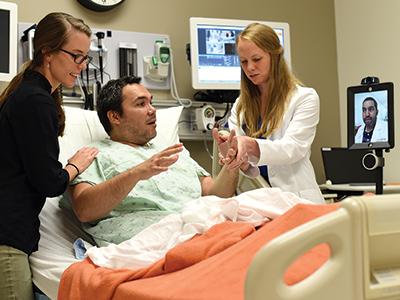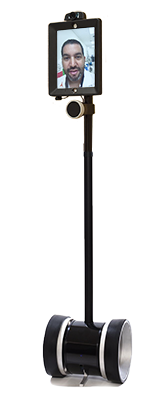As if the UT Austin School of Nursing’s Simulation Center didn’t contain enough of the latest cutting-edge technology, the newest member of the teaching staff, Robo-Advanced Practice Registered Nurse (RoboAPRN), recently reported for duty.
The robot arrived at the behest of Dr. Valerie Danesh, assistant professor; Dr. Donna Rolin, assistant professor of clinical nursing; Scott Hudson, director of simulation and skills labs; and Sean White, instructional technology specialist; who received a 2017 Faculty Innovation grant for $9,764 for their project “RoboAPRN: Telepresence Robots in Healthcare Education.”

The project uses remote presence telehealth technology to bridge undergraduate (initial licensure as a registered nurse) and graduate (advanced practice licensure as nurse practitioner and clinical nurse specialist) programs and promote learning across role preparations. The robot introduces remote presence enabled communication and assessments for patient care to prepare students for telemedicine use in the workforce.
Remote presence is a form of telemedicine that is increasing across all health care settings, with rapid uptake in psychiatry and in rural and hospital-based care. Telemedicine skills recently became a part of the School of Nursing’s Psychiatric Mental Health Nurse Practitioner program after the need to reach patients with mental health illnesses across a largely rural state became apparent.
“There is a dire shortage of psychiatric providers in Texas and across the nation,” Rolin said. “In addition, the demand for trained telehealth professionals is outstripping supply. Now, with this new technology, we can teach students how to assess and provide interactive care for many more patients who reside miles away from clinics or hospitals.”

The new remote presence/telemedicine technology will home in on introducing telemedicine delivery in the health care education setting in the School’s simulation lab, with an emphasis on psychiatric/mental health care delivery.
“The addition of telehealth to our simulation training environment will help prepare students for a rapidly expanding market for clinicians with telehealth proficiency,” Danesh said. “Our Simulation Center already delivers multidisciplinary simulations and debriefings with onsite interdependencies engaging several other health profession schools and colleges at UT Austin. With RoboAPRN, they can broaden their skills in preparation for entering a rapidly changing health care landscape.”
“It’s often said that the proof is in the pudding, so our challenge is to ensure that students gain the most from the instructional delivery and are able to experience effective learning,” Sean White said. “If we succeed, I anticipate the School of Nursing will expand its telepresence technology, opening the door to greater instructional usage and better health care access.”
This year the Faculty Innovation Center and Project 2021 received a total of 57 proposals and funded nine.
“We’re delighted to be funded by the UT Austin Faculty Innovation Center, which will enable us to move forward with this exciting and transformative technology,” said Scott Hudson, director of the Simulation Center. “We will perform pilot tests and course curriculum review during this fall and plan a ‘go-live’ for course integration in the spring 2018 semester.”

